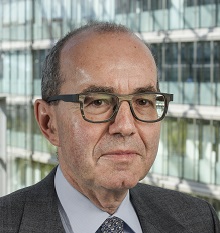The name Kantha Bopha is well known in Switzerland. Beat Richner, pediatrician, cello player, and savvy fundraiser, has been working there tirelessly for over 20 years on his life-long project. He had already worked at the Children’s Hospital in Phnom Penh in the early 70’s, then the terror of the Khmer Rouge’s reign forced him to flee, and he only managed to return in 1991. The foundation “Children’s Hospital, Kantha Bopha Dr. Beat Richner,” runs five children’s hospitals with 2,500 employees in Phnom Penh and Siem Reap in Cambodia. It rightly carries his name because without Richner these hospitals would simply not exist. Thus, last week I was very moved when I learned about his illness, forcing him to resign from running the hospital. The news came only a few days after I had actually managed to visit his pediatric hospital of Siem Reap, accompanied by Dr. Denis Laurent, next to Beat Richner the only foreigner among the hospital staff.
Driven by his mission to help children in need, Richner has expanded his pediatric hospitals over the last 25 years, and fought tirelessly for them both in his country, Switzerland, as well as in Cambodia. He strongly believes that children are entitled to a non-discriminatory, free-of-charge, decent and sound medical care in one of the poorest countries in the world. His deeply held conviction led him over the years to confront most of the stakeholders who have a say in international health policy: WHO, Global Fund, Swiss Federal Office of Public Health, Swiss Agency for Development and Cooperation (SDC) as well as big pharma companies. Against the established view that first-world medicine could possibly not be offered in a sustainable way in a least developed country, he was an extremely effective fundraiser and advocate for the needs of children. Thus, notwithstanding significant support from the SDC and substantive efforts to secure sustainable long-term funding for the hospitals, he kept on criticizing SDC for the last 20 years. In his view, it was difficult to accept that despite a sharp rise in the number of patients and positive assessment of the hospital performance by the SDC, their contribution remained steady at a rate of four million Swiss francs per year, equivalent to about 10 per cent of the overall budget of the five hospitals.
I was well aware of the controversies and the antagonism before I visited the Kantha Bopha Hospital in Siem Reap. However, the mere fact that the hospitals were still in existence after 25 years, had stimulated my interest. And what I saw in Siem Reap compelled more than admiration: it also brought tremendous respect. Yes, the hospital has modern facilities equipped with MRI and CT scanners, but it is nothing compared to the sophistication, even luxury, you would find in a Swiss children’s hospital. Only the laboratories and the operating theatres have air conditioning, unlike the fairly large patients’ wards. The impression is one of functionality and down-to-earth medical care. Furthermore, the numbers are impressive: the five Kantha hospitals cover over 80 per cent of the treatment of seriously ill children in Cambodia, each year treating more than 130,000 inpatient children, almost 800,000 outpatients, and carrying out more than 20’000 surgical interventions. And the medical outcomes are impressive as exemplified by just one example. Thanks to the neonatal and maternal department in Siem Reap, transmission of HIV / AIDS from mother to child has been reduced from 35 to under 2 per cent.
Up to now, more than 30 million Swiss francs of the 40 million franc annual budget of the five hospitals, is covered by donations* from Switzerland. That much I knew and obviously raises questions about the sustainability over the long term. However, I was impressed by the success in securing local funding demonstrating the Cambodian commitment to the hospitals. In 2016, the Cambodian government has increased its contribution to the Kantha Bopha hospitals from three to six million Swiss francs. And, although still run by the Foundation, the hospitals are formally integrated into the Cambodian health system, including recognition as teaching hospitals, forming doctors and other health care professionals. It is obvious that the country is very proud of Kantha Bopha. One expression of this pride and commitment to Kantha Bopha is the recent introduction of a new innovative financing mechanism. Since February 2017, for every entrance paid to the Angkor Wat UNESCO World Heritage cultural monuments, two dollars have been donated to funding Kantha Bopha. In February alone, this amounted to new local revenue of half a million dollars. Yet, such an innovative funding approach which will significantly increase national funding is not enough. More support is needed. For example, Denis Laurent during my visit clearly expressed the desire for some assistance in finding sustainable funding solutions. That said, the country’s development and commitment to Kantha Bopha hospitals are truly positive steps towards sustainability, and personally, I do hope that Switzerland and other countries can make an important contribution to the running of Kantha Bopha.






